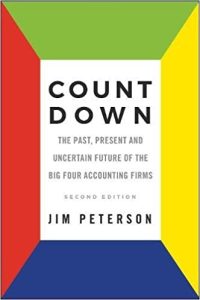Ny bog om Big Four

Jim Peterson var General Counsel for Arthur Andersen & Co fra 1982 indtil juni 2001. Altså fatrådte Jim sin stilling kun godt et halvt år inden Enron skandalen slog benene væk under Arthur Andersen og Co.
Jim er mangeårig observatør af Big Four og har nu begået en bog, der omhandler hans bud på hvordan professionens ledende aktører skulle indrette sig, for at stå rustet til det 21. århundredes krav.
Andersen Partners’ Website Dear Partners –
As some of you will have seen this week, from reading my blog, Re:Balance, or other related media, it is my pleasure to announce the scheduled release on October 15th by Emerald Publishing of my book, “Count Down – The Past, Present and Uncertain Future of the Big Four Accounting Firms.”
Those familiar with my writing since 2002 – first in my column, “Balance Sheet,” in the International Herald Tribune and then on the blog, will see that it gathers together and addresses the serious issues confronting the viability of the Big Audit model by which financial statement assurance has been delivered by the Big Four to the world’s large public companies, and indeed the survivability of the business model of the Big Four themselves.
Pre-publication ordering is now available, either through Amazon or on the book’s page at Emerald – the latter including a 30 % publisher’s discount (write me for the details).
Synopsis information is available on any of the links above. A very short summary from the publisher is here:
The post-Enron disintegration of Arthur Andersen in 2002 reduced the large international accounting firms to the Big Four – Deloitte, EY, KPMG and PwC.
Despite market dominance and annual global revenue above $ 120 billion, those firms face serious threats:
Dissatisfaction with the traditional auditor’s report.
The “expectations gap” between their performance and the desires of users.
And especially, their exposure to a litigation judgment on the scale that destroyed Arthur Andersen.
Count Down looks at the challenges facing the Big Four and proposes an evolved model for Big Audit, fit to serve the capital markets of the 21st century.
Duane R. Kullberg, the Firm’s Managing Partner and CEO from 1980 to 1989 and our leader when I joined the Firm in the Legal Group in 1982, did me the favor of this observation for the book’s cover:
“This book lifts the lid on the story behind the financial statements of the world’s major companies. If you want to understand the system that is allegedly validating the reported data – and why the system is a clone of the Maginot Line – expensive, obsolete and irrelevant – read on. Weak as the present system is, there is a solution. It will take a major change in regulatory attitude and a fresh approach, unfettered by history. The section on the imaginative use of Big Data is worth study by itself.”
I will be most enthusiastic to know of your interest and to have your reactions. Please write me with any questions or inquiries.
– Jim Peterson
To order
From Emerald Books
From Amazon
Inquiries, and for the pre-publication discount — write jrpllc@mac.com
The post-Enron disintegration of Arthur Andersen in 2002 reduced to the surviving Big Four the number of international accounting firms that audit nearly all of the world’s largest public companies — Deloitte, EY, KPMG and PwC.
Despite their strengths — market dominance, double-digit annual growth in non-audit services and continued revenue expansion to a global total above $ 120 billion in 2014 – the viability of the Big Four and their business model faces serious threats:
- Widespread dissatisfaction with the standard form and language of their core product — the traditional “pass-fail” auditor’s report.
- The persistent “expectations gap” between their perceived performance quality and the stated desires of information users.
- Difficult relations with regulators and oversight agencies.
- And especially, the questionable ability of the Big Four and their partners to survive a “black swan” financial shock – a litigation judgment or law enforcement sanction on the scale that destroyed Arthur Andersen.
Count Down looks at the complex challenges facing the Big Four, questions the feasibility and achievability of the various proffered “solutions,” and proposes an evolved model for Big Audit that would be both sustainable for the large firms and fit to serve the capital markets of the 21st century.
“This book lifts the lid on the story behind the financial statements of the world’s major companies. If you want to understand the system that is allegedly validating the reported data – and why the system is a clone of the Maginot Line – expensive, obsolete and irrelevant – read on. Weak as the present system is, there is a solution. It will take a major change in regulatory attitude and a fresh approach, unfettered by history. The section on the imaginative use of Big Data is worth study by itself. “
— Duane R. Kullberg, Arthur Andersen & Co., S.C. Chief Executive Officer, 1980-1989
“Illusions of safety in size doomed allosaurus, empires, and auto makers. In his Count Down, Jim Peterson examines the fragility of the ineffectual audit regime, and the imminent threats to its survival. Peterson combines the insider’s knowledge with an outsider’s critical but sympathetic perspective and suggestions in this fascinating and insightful volume—a must-read for accountants and students of accounting.”
— Shyam Sunder, James L. Frank Professor of Accounting, Economics, and Finance, Yale School of Management


